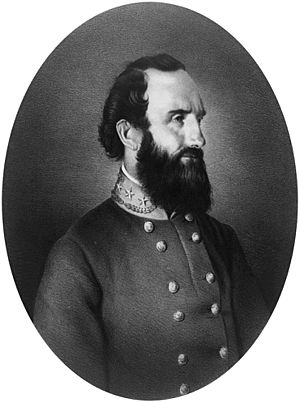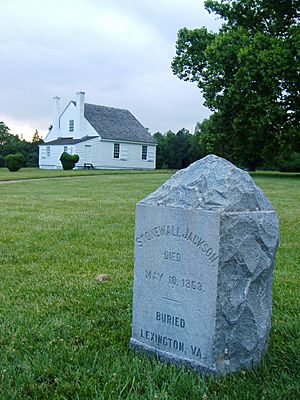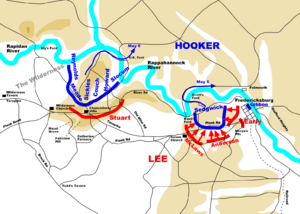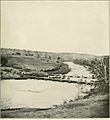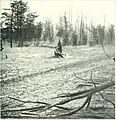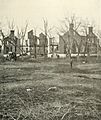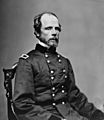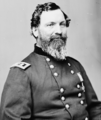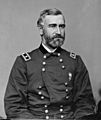Battle of Chancellorsville facts for kids
Quick facts for kids Battle of Chancellorsville |
|||||||
|---|---|---|---|---|---|---|---|
| Part of the American Civil War | |||||||
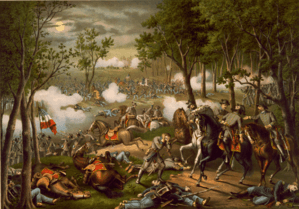 Battle of Chancellorsville, by Kurz and Allison, 1889 (Apocryphal painting depicts the wounding of Confederate Lt. Gen. Stonewall Jackson on May 2, 1863) |
|||||||
|
|||||||
| Belligerents | |||||||
| Commanders and leaders | |||||||
| Joseph Hooker | Robert E. Lee Stonewall Jackson † J. E. B. Stuart |
||||||
| Units involved | |||||||
| Army of the Potomac | Army of Northern Virginia | ||||||
| Strength | |||||||
|
Chancellorsville campaign:
|
60,298 | ||||||
| Casualties and losses | |||||||
|
Chancellorsville campaign:
|
12,764
(1,665 killed
9,081 wounded 2,018 captured/missing) |
||||||
The Battle of Chancellorsville was a big battle during the American Civil War. It happened from April 30 to May 6, 1863. Many people think it was Confederate General Robert E. Lee's best victory. He won against the Union Army.
However, this victory came with a huge cost for the Confederates. Their brave general, Stonewall Jackson, was shot by his own soldiers by mistake. They thought he and his group were Union cavalry. Because of this sad loss, Lee's win at Chancellorsville is sometimes called a pyrrhic victory. This means a victory that costs so much it feels like a defeat.
Contents
Background to the Battle
After the Battle of Fredericksburg, the Union army was in a tough spot. Their leader, Major General Ambrose Burnside, was not getting along with his other generals. They felt he wasn't good enough to lead. Even Burnside himself had turned down the job twice before.
Finally, President Abraham Lincoln agreed and put General Joseph Hooker in charge. Hooker quickly made the army stronger and boosted their spirits. He proudly called them "the finest army on the planet."
Hooker's Plan for Attack
General Hooker came up with a smart plan for a spring attack. He wanted to make Lee's Army of Northern Virginia leave Fredericksburg, Virginia. He also hoped to destroy Lee's army completely.
His plan had two main parts:
- First, he would send 10,000 cavalry (soldiers on horseback) to raid Richmond, Virginia. This would cut off Lee's communication and supply lines to the Confederate capital.
- Second, most of his infantry (foot soldiers) would cross the Rappahannock and Rapidan Rivers. These rivers were about 40 miles north of where the Confederates were.
- The rest of his army would cross the river at Fredericksburg. This would attack Lee from the front.
This plan was like a giant pincer movement. If it worked, it would surround the enemy army.
The Battle Begins
First Moves and Surprises
Hooker's army crossed the Rappahannock River on April 30, 1863. This put his army on the side, or flank, of Lee's forces. Hooker's Union army had 97,382 men. This was twice as many soldiers as Lee's army, which had 57,352 men.
But instead of running away, Lee did something bold. He split his army! He decided to attack Hooker while the Union army was still in the thick, wild forest known as the "wilderness."
Lee sent General Jackson with 30,000 Confederate soldiers to attack the Union's right side. He also sent Major General Jubal Early with 10,000 soldiers to defend Fredericksburg.
By the afternoon of April 30, about 50,000 Union troops reached an important road crossing. There was a tavern there called Chancellorsville. Hooker decided to stop and wait for more Union troops. His officers wanted to keep moving, but Hooker held back.
On May 1, Stonewall Jackson found two groups of Confederates building defenses at Zoan Church. He told them to drop their shovels and pick up their rifles. He ordered them to move forward and attack the Union soldiers. The Union army had just decided to move forward again and was not expecting any Confederates.
Hooker ordered his soldiers to go back and set up defensive positions in the wilderness.
Jackson's Famous Flank Attack
On the morning of May 2, Jackson moved his corps (a large military unit) to attack the Union's left side. There was fighting throughout the day. At 5:20 in the afternoon, Jackson launched a big attack on the Union's XI Corps. The Union soldiers fought back, but the fighting stopped when it got dark.
That night, Jackson was checking the area with some of his officers. Sadly, his own soldiers mistakenly shot him. He died eight days later from pneumonia after losing his left arm. General J.E.B. Stuart took over command of Jackson's Corps for a short time.
The Main Fighting at Chancellorsville
On May 3, the Confederates attacked again. They pushed Hooker's army back towards the river crossings, called fords. This day saw the most intense fighting of the battle. Both sides of the Confederate army attacked. Their artillery (big guns) fired heavily on the Union line at Hazel Grove.
The larger Union army held most of the best spots on the battlefield. But the most important spot was Hazel Grove. This was a high, open area that overlooked all the Union positions. General Stuart understood how important this spot was. Early in the morning, Confederates attacked Hazel Grove. They captured about 100 Union soldiers and four artillery pieces.
For reasons still unclear, Hooker had ordered his artillery to move away from Hazel Grove. So, when the Confederates attacked, most of the big guns were already gone. This was a huge mistake. Now, Confederate artillery could easily fire down on the Union positions. This forced the Union line to fall back with their backs to the river.
Meanwhile, other Union forces were moving towards Lee from the east. Lee split his army again. He met and defeated these Union soldiers near Salem Church (Fredericksburg). This was the bloodiest day of the entire battle. The fighting at Salem Church caused more injuries and deaths than the whole First Battle of Bull Run.
After the Battle
On May 6, Hooker's army crossed back over the Rappahannock River. The Union army lost a total of 17,278 soldiers (killed, wounded, or missing). Lee's Confederate army lost 12,826. It was a huge win for Lee.
But Lee could not replace General Jackson, who was a brilliant leader. Hooker was the second general of the Army of the Potomac to be replaced after just one battle.
Hooker tried to explain why they lost. He said the cavalry raid didn't cut Lee's supply lines. He also complained that the XI Corps, which had many German-American and other new immigrant soldiers, ran away instead of fighting. This group was even called the "flying Dutchmen" after this event. However, they later fought bravely at the Battle of Missionary Ridge.
Even though Hooker tried to blame others, he was replaced by General George Meade. Just a few weeks later, Lee would move north to fight the Union forces again at the famous Battle of Gettysburg.
Interesting Fact
Did you know that Stonewall Jackson's arm is buried in a different place than his body?
Jackson was hit by three bullets. Two hit his left arm, and one hit his right hand. Because of his serious injuries, his left arm had to be amputated (cut off).
Jackson sadly died from problems caused by pneumonia on May 10, 1863. This was eight days after he was shot. He was buried in Oak Grove Cemetery in Lexington, Virginia.
His amputated arm was buried separately by his chaplain (a military priest), Beverly Tucker Lacy. This happened at the J. Horace Lacy house, called "Ellwood." Union soldiers later reburied it in an unknown spot in 1864.
In 1903, one of Jackson's officers put up a monument where the arm was thought to be buried. This monument to Stonewall Jackson's arm in Locust Grove, Virginia, has now become a popular place for tourists to visit.
Images for kids
-
Troops crossing the Rapidan at Germanna Ford
-
Ruins of the Chancellor House which was the headquarters of Federal General Joseph Hooker of the Army of the Potomac during the battle, later burned, May 1863
-
Chancellorsville, actions on May 3, 10 a.m. to 5 p.m., including the Second Battle of Fredericksburg and the Battle of Salem Church
-
Chancellorsville Campaign, 3 May 1863 (Battle of Salem Church: Situation at 1600)
-
Soldiers of the VI Corps, Army of the Potomac, in trenches before storming Marye's Heights at the Second Battle of Fredericksburg during the Chancellorsville campaign, Virginia, May 1863. This photograph (Library of Congress #B-157) is sometimes mistakenly labeled as taken at the 1864 Siege of Petersburg, Virginia.
-
Maj. Gen. Joseph Hooker, (Commanding)
-
Maj. Gen. John F. Reynolds, I Corps
-
Maj. Gen. Darius N. Couch, II Corps
-
Maj. Gen. Daniel E. Sickles, III Corps
-
Maj. Gen. George G. Meade, V Corps
-
Maj. Gen. John Sedgwick, VI Corps
-
Maj. Gen. Oliver O. Howard, XI Corps
-
Maj. Gen. Henry W. Slocum, XII Corps
-
Maj. Gen. George Stoneman, Cav. Corps
-
Gen. Robert E. Lee, (Commanding)
-
Lt. Gen. James Longstreet, I Corps
-
Lt. Gen. Stonewall Jackson, II Corps
-
Maj. Gen. J.E.B. Stuart, Cav. Corps
-
Brig. Gen. Charles Devens, wounded
-
Brig. Gen. Amiel W. Whipple, mortally wounded
-
Brig. Gen. Gershom Mott, wounded
-
Brig. Gen. William Hays, wounded
-
Lt. Gen. Stonewall Jackson, mortally wounded
-
Maj. Gen. Ambrose P. Hill, wounded
-
Brig. Gen. Stephen D. Ramseur, wounded
-
Brig. Gen. Edward A. O'Neal, wounded
-
Col. Stapleton Crutchfield, wounded
See also
 In Spanish: Batalla de Chancellorsville para niños
In Spanish: Batalla de Chancellorsville para niños


